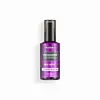What's inside
What's inside
 Key Ingredients
Key Ingredients

 Benefits
Benefits

 Concerns
Concerns

 Ingredients Side-by-side
Ingredients Side-by-side

Cyclopentasiloxane
EmollientDimethicone
EmollientCyclohexasiloxane
EmollientIsododecane
EmollientIsopropyl Myristate
EmollientMacadamia Ternifolia Seed Oil
EmollientAmodimethicone
Squalane
EmollientVegetable Oil
Skin ConditioningIsopropyl Palmitate
EmollientTocopheryl Acetate
AntioxidantArgania Spinosa Kernel Oil
EmollientCarthamus Tinctorius Seed Oil
MaskingHelianthus Annuus Seed Oil
EmollientPersea Gratissima Oil
Skin ConditioningVitis Vinifera Seed Oil
EmollientCamellia Japonica Seed Oil
EmollientOryza Sativa Bran Oil
EmollientPrunus Amygdalus Dulcis Oil
Skin ConditioningPrunus Armeniaca Kernel Oil
MaskingSimmondsia Chinensis Seed Oil
EmollientRicinus Communis Seed Oil
MaskingLimnanthes Alba Seed Oil
Skin ConditioningSesamum Indicum Seed Oil
EmollientPlukenetia Volubilis Seed Oil
EmollientTocopherol
AntioxidantParfum
MaskingCyclopentasiloxane, Dimethicone, Cyclohexasiloxane, Isododecane, Isopropyl Myristate, Macadamia Ternifolia Seed Oil, Amodimethicone, Squalane, Vegetable Oil, Isopropyl Palmitate, Tocopheryl Acetate, Argania Spinosa Kernel Oil, Carthamus Tinctorius Seed Oil, Helianthus Annuus Seed Oil, Persea Gratissima Oil, Vitis Vinifera Seed Oil, Camellia Japonica Seed Oil, Oryza Sativa Bran Oil, Prunus Amygdalus Dulcis Oil, Prunus Armeniaca Kernel Oil, Simmondsia Chinensis Seed Oil, Ricinus Communis Seed Oil, Limnanthes Alba Seed Oil, Sesamum Indicum Seed Oil, Plukenetia Volubilis Seed Oil, Tocopherol, Parfum
Water
Skin ConditioningCetearyl Alcohol
EmollientBehentrimonium Chloride
PreservativeStearamidopropyl Dimethylamine
EmulsifyingParfum
MaskingAmodimethicone
Behentrimonium Methosulfate
Lactic Acid
BufferingIsopropyl Alcohol
SolventPhenoxyethanol
PreservativeDimethicone PEG-8 Meadowfoamate
EmollientEthylhexylglycerin
Skin ConditioningDisodium EDTA
Ethylhexyl Methoxycinnamate
UV AbsorberHexylene Glycol
EmulsifyingCetrimonium Chloride
AntimicrobialTrideceth-10
CleansingGlycerin
HumectantFructose
HumectantGlucose
HumectantCarnosine
Skin ConditioningDextrin
AbsorbentSucrose
HumectantUrea
BufferingBiosaccharide Gum-4
Skin ConditioningLinum Usitatissimum Seed Extract
PerfumingCaesalpinia Spinosa Gum
Skin ConditioningAlanine
MaskingAspartic Acid
MaskingGlutamic Acid
HumectantHexyl Nicotinate
EmollientPotassium Sorbate
PreservativeSodium Benzoate
MaskingWater, Cetearyl Alcohol, Behentrimonium Chloride, Stearamidopropyl Dimethylamine, Parfum, Amodimethicone, Behentrimonium Methosulfate, Lactic Acid, Isopropyl Alcohol, Phenoxyethanol, Dimethicone PEG-8 Meadowfoamate, Ethylhexylglycerin, Disodium EDTA, Ethylhexyl Methoxycinnamate, Hexylene Glycol, Cetrimonium Chloride, Trideceth-10, Glycerin, Fructose, Glucose, Carnosine, Dextrin, Sucrose, Urea, Biosaccharide Gum-4, Linum Usitatissimum Seed Extract, Caesalpinia Spinosa Gum, Alanine, Aspartic Acid, Glutamic Acid, Hexyl Nicotinate, Potassium Sorbate, Sodium Benzoate
 Reviews
Reviews

Ingredients Explained
These ingredients are found in both products.
Ingredients higher up in an ingredient list are typically present in a larger amount.
This water-soluble silicone is used for its hydrating and softening properties. It is used to add a silky feel to skincare products and has great benefits for haircare.
In haircare, this ingredient:
- Adds shine
- Protects color
- Offers thermal protection
- Boosts hair strength
- Does not build up as easily
Parfum is a catch-all term for an ingredient or more that is used to give a scent to products.
Also called "fragrance", this ingredient can be a blend of hundreds of chemicals or plant oils. This means every product with "fragrance" or "parfum" in the ingredients list is a different mixture.
For instance, Habanolide is a proprietary trade name for a specific aroma chemical. When used as a fragrance ingredient in cosmetics, most aroma chemicals fall under the broad labeling category of “FRAGRANCE” or “PARFUM” according to EU and US regulations.
The term 'parfum' or 'fragrance' is not regulated in many countries. In many cases, it is up to the brand to define this term.
For instance, many brands choose to label themselves as "fragrance-free" because they are not using synthetic fragrances. However, their products may still contain ingredients such as essential oils that are considered a fragrance by INCI standards.
One example is Calendula flower extract. Calendula is an essential oil that still imparts a scent or 'fragrance'.
Depending on the blend, the ingredients in the mixture can cause allergies and sensitivities on the skin. Some ingredients that are known EU allergens include linalool and citronellol.
Parfum can also be used to mask or cover an unpleasant scent.
The bottom line is: not all fragrances/parfum/ingredients are created equally. If you are worried about fragrances, we recommend taking a closer look at an ingredient. And of course, we always recommend speaking with a professional.
Learn more about Parfum